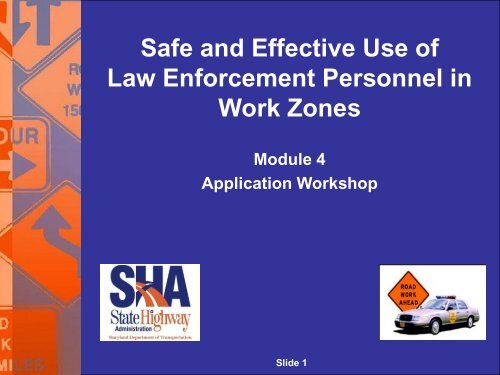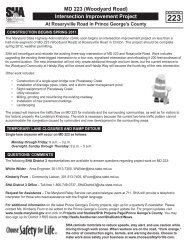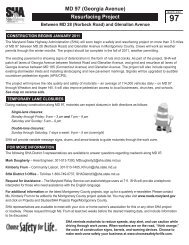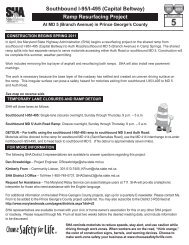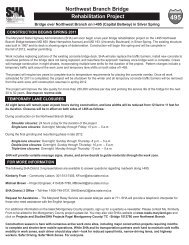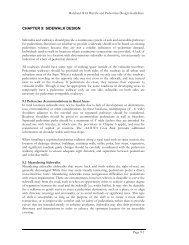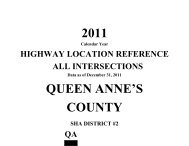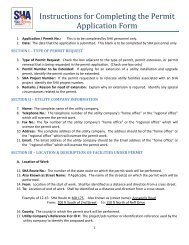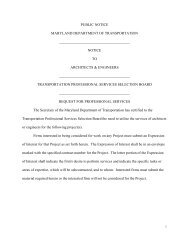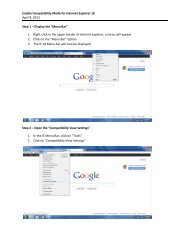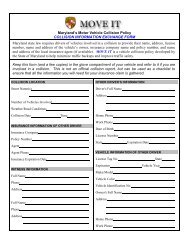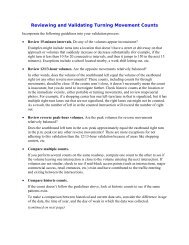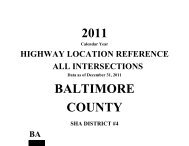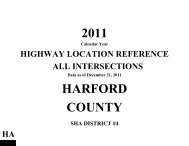Safe and Effective Use of Law Enforcement Personnel in Work Zones
Safe and Effective Use of Law Enforcement Personnel in Work Zones
Safe and Effective Use of Law Enforcement Personnel in Work Zones
Create successful ePaper yourself
Turn your PDF publications into a flip-book with our unique Google optimized e-Paper software.
<strong>Safe</strong> <strong>and</strong> <strong>Effective</strong> <strong>Use</strong> <strong>of</strong><br />
<strong>Law</strong> <strong>Enforcement</strong> <strong>Personnel</strong> <strong>in</strong><br />
<strong>Work</strong> <strong>Zones</strong><br />
Module 4<br />
Application <strong>Work</strong>shop<br />
Slide 1
Module 4<br />
Module 4 takes you through an example problem<br />
step by step. In this module, you will be required<br />
to apply concepts presented <strong>in</strong> earlier modules.<br />
The workbook for Module 4 <strong>in</strong>cludes key<br />
references you need to complete this example.<br />
The example is not graded. A solution to the<br />
problem can be pr<strong>in</strong>ted at the end <strong>of</strong> the lesson,<br />
but we encourage you to try <strong>and</strong> complete the<br />
example without look<strong>in</strong>g at the solution.<br />
Slide 2
Objectives <strong>of</strong> this Lesson<br />
When you complete this lesson, you will be able to<br />
apply the concepts learned <strong>in</strong> previous modules to<br />
a freeway lane closure <strong>and</strong> determ<strong>in</strong>e:<br />
• Sign types <strong>and</strong> spac<strong>in</strong>g <strong>in</strong> the advance warn<strong>in</strong>g<br />
area<br />
• Taper lengths<br />
• Device spac<strong>in</strong>g on tapers<br />
• LEO vehicle placement under light traffic<br />
conditions<br />
• The need for relocation <strong>of</strong> LEO vehicle when<br />
queues develop<br />
Slide 3
Example Problem<br />
This example is for a four-lane<br />
roadway <strong>in</strong> a rural area with little<br />
or no traffic congestion.<br />
Road Type: Rural Freeway<br />
Speed = 55 mph<br />
Lane Width (W) = 12 Feet<br />
<strong>Work</strong> Zone Duration = 6 Hours, Daytime<br />
LEOs should focus on traffic approach<strong>in</strong>g<br />
the work zone.<br />
Slide 4
Example Problem<br />
For this problem:<br />
1. Determ<strong>in</strong>e the appropriate TTC typical<br />
application.<br />
2. Determ<strong>in</strong>e signs <strong>and</strong> note the sign spac<strong>in</strong>g from<br />
the typical application above.<br />
3. Calculate m<strong>in</strong>imum taper <strong>and</strong> buffer lengths.<br />
4. Recommend the appropriate location for the<br />
LEO vehicle.<br />
Road Type: Rural Freeway<br />
Speed = 55 mph<br />
Lane Width (W) = 12 Feet<br />
<strong>Work</strong> Zone Duration = 6 Hours, Daytime<br />
Slide 5
Step 1: Determ<strong>in</strong>e the appropriate TTCTA<br />
Type <strong>of</strong> Roadway - Freeway<br />
Type <strong>of</strong> <strong>Work</strong> - Stationary-Roadway<br />
Type <strong>of</strong> Improvement - Right Lane Closure<br />
Speed - > 40mph<br />
The appropriate TTCTA is<br />
MD 104.05-07<br />
Road Type: Rural Freeway<br />
Speed = 55 mph<br />
Lane Width (W) = 12 Feet<br />
<strong>Work</strong> Zone Duration = 6 Hours, Daytime<br />
Slide 6
Step 2: Signs & Sign Spac<strong>in</strong>g<br />
Refer to the Book <strong>of</strong> St<strong>and</strong>ards<br />
MD 104.05-07 to determ<strong>in</strong>e<br />
signs <strong>and</strong> sign spac<strong>in</strong>g.<br />
Road Type: Rural Freeway<br />
Speed = 55 mph<br />
Lane Width (W) = 12 Feet<br />
<strong>Work</strong> Zone Duration = 6 Hours, Daytime<br />
Slide 7
Step 2: Signs & Sign Spac<strong>in</strong>g<br />
From the typical application MD 104.05-07,<br />
we know:<br />
1. The messages on signs to be <strong>in</strong>stalled<br />
2. The sign spac<strong>in</strong>g<br />
Slide 8
Sign Spac<strong>in</strong>g Exercise<br />
Match the correct sign to the correct location.<br />
1) RIGHT LANE CLOSED 1/2 MILE<br />
2) ROAD WORK 1 MILE<br />
3)<br />
Sign A Sign B Sign C<br />
Slide 9
Step 3: Taper & Buffer Length<br />
Us<strong>in</strong>g the typical application MD 104.05-07, with a<br />
motorist speed <strong>of</strong> 55 MPH, we can know that:<br />
• Sign A should be placed 800 feet from the<br />
beg<strong>in</strong>n<strong>in</strong>g <strong>of</strong> the taper<br />
• Sign B should be placed 800 feet upstream <strong>of</strong><br />
Sign A, 2600 feet from the beg<strong>in</strong>n<strong>in</strong>g <strong>of</strong> the<br />
taper<br />
• Sign C should be placed ½ mile upstream <strong>of</strong><br />
Sign B, 1 mile from the beg<strong>in</strong>n<strong>in</strong>g <strong>of</strong> the taper<br />
Slide 10
Step 3: Taper & Buffer Length<br />
Calculate the appropriate taper length for the<br />
roadway below.<br />
What is the Merg<strong>in</strong>g Taper Length (L)?<br />
L = WS = 12 ft x 55<br />
L = 660 ft<br />
Slide 11<br />
L
Taper Lengths<br />
The taper calculation gives L= 660 feet. However, accord<strong>in</strong>g to<br />
Maryl<strong>and</strong> Book <strong>of</strong> St<strong>and</strong>ards, MD 104.01-80, the m<strong>in</strong>imum merg<strong>in</strong>g<br />
taper length shall be 1000 feet for all expressways <strong>and</strong> freeways.<br />
Therefore,<br />
• The merg<strong>in</strong>g taper length L = 1000 feet<br />
• The term<strong>in</strong>ation taper length is 100 feet<br />
Slide 12<br />
L
Step 3: Taper & Buffer Length<br />
The Maryl<strong>and</strong> Book <strong>of</strong> St<strong>and</strong>ards provides guidance<br />
regard<strong>in</strong>g the m<strong>in</strong>imum buffer lengths. The typical<br />
application MD 104.01-81 shows the follow<strong>in</strong>g table:<br />
In this case, with roadway speed <strong>of</strong> 55 MPH, the<br />
m<strong>in</strong>imum buffer length is 495 feet .<br />
Slide 13
Step 4: LEO Vehicle Placement<br />
Where should the LEO vehicle be placed when<br />
traffic is mov<strong>in</strong>g freely?<br />
1) Placement A<br />
2) Placement B<br />
3) Placement C<br />
C<br />
B<br />
Speed = 55 mph<br />
Lane Width (W) = 12 Feet<br />
<strong>Work</strong> Zone Duration = 6 Hours, Daytime<br />
Slide 14<br />
A
Step 4: LEO Vehicle Placement<br />
Where should the LEO vehicle be placed when<br />
traffic queue extends ¼ mile beyond advance<br />
warn<strong>in</strong>g area?<br />
The LEO vehicle should be moved to a location<br />
¼ mile before the end <strong>of</strong> the queue.<br />
Slide 15<br />
¼ mile
1. 3, 1, 2<br />
2. A<br />
Answer Key<br />
Slide 16
Congratulations<br />
You have completed all four modules <strong>of</strong> this course. Follow the<br />
<strong>in</strong>structions below to document the completion <strong>of</strong> your tra<strong>in</strong><strong>in</strong>g.<br />
1. Click on the “Certificate <strong>of</strong> Completion” under course materials on the course ma<strong>in</strong><br />
page. On the left near the top, type <strong>in</strong> your name, agency name <strong>and</strong> address.<br />
2. Click on “Pr<strong>in</strong>t Form” located near the top right to make two copies. Reta<strong>in</strong> one for<br />
your records <strong>and</strong> submit the other for your auxiliary personal file.<br />
3. Click on “Submit by email”. When the new email opens, it will already have the<br />
subject — LEO Course Completion, the recipient’s email address —<br />
mpaylor@sha.state.md.us <strong>and</strong> the xml file as an attachment. Send the email.<br />
4. If you do not have MS Outlook <strong>in</strong>stalled on your computer, you may not be able to<br />
send the email as directed above. If you have tried <strong>and</strong> have been unable to send<br />
the email, please save a copy <strong>of</strong> the completed “Certificate <strong>of</strong> Completion” as a<br />
PDF <strong>and</strong> email it to mpaylor@sha.state.md.us. You may also pr<strong>in</strong>t, scan <strong>and</strong> email<br />
the completed “Certificate <strong>of</strong> Completion” to mpaylor@sha.state.md.us.<br />
5. Note the expiration date at the bottom <strong>of</strong> the letter. If you are deployed <strong>in</strong> SHA’s<br />
work zones after this expiration date, you will be <strong>in</strong> violation <strong>of</strong> the Interagency<br />
Agreement. To ensure that you are <strong>in</strong> conformance with the Interagency<br />
Agreement, please ensure that you undergo SHA’s <strong>Work</strong> Zone <strong>Law</strong> <strong>Enforcement</strong><br />
Tra<strong>in</strong><strong>in</strong>g Course or an SHA approved equivalent every four years.<br />
Slide 17
Contact Information<br />
Clarence Haskett<br />
Maryl<strong>and</strong> State Highway Adm<strong>in</strong>istration<br />
Office <strong>of</strong> Traffic <strong>and</strong> <strong>Safe</strong>ty<br />
410-787-5876<br />
chaskett@sha.state.md.us<br />
Slide 18


